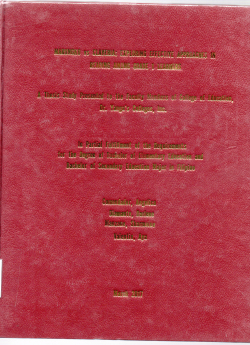Marungko vs Claveria: Exploring Effective approaches in Reading Among Grade 1 Learners

Type
Thesis
Authors
Comendador ( Angelica et al. )
Category
COED
[ Browse Items ]
Pages
51 p.
Abstract
Reading makes every person understand things better: Through reading gathering information and source would be easy. In DepEd memo Sec. 10" no read, No Pass policy" a memorandun states that all primary students should be able to read in Filipino. The researchers therefore aim to help one of the problems of teacher in reading proficiency of learner by presenting marungko and claveria approach, not only to develop but also to improve the skill of the learner in reading. In marungko approach, the pupils will learn the sounds of the alphabets than reading it. Why the claveria approaches requires pictures so the learners will be analyze and master not just the symbol but also the sound of the letter. With this, The researches would like to know which is the better approach for teachers in teaching grade 1 learners to read. Respondents were selected by simple ramdom sampling specifically through drawlots. There were a total of 60 pupils of grade 1 from chosen two section of Dr. Yanga's Colleges, Inc. The participants were divided into two (30 group), particularly, for the marungko and claveria approach to compare the outcomes of both approaches . The tool that was used by the researchers was from Phil- IRI for grade 1 learners Pre-test was conducted before teaching the approach . The pre-test exam of the participants was consisted 20 words from the paragraph of the post- test exam.The participant's pre-test result classified them if they are non-reader, frustrated , instructional and independent reader. If the participant's could hardly read and could not pronounce the words, he/she will be categorized as a non reader. If a participant can read a 3-8 words that were given by the researchers, he/she will fall under the frustrated group. A participant will fall under the instructional reader if he/she can read 9-15 words. A participants was said to be an independent reader if he/she can read 16-20 words. The post test was conducted after one month teaching of the approach. Pre-teat result of the marungko group and claveria group have same result, there were two non readers, and three frustated, seven instructional and 18 independent readers. However, the researchers conducted the approaches, by group, the marungko group did better in improving their reading skills, With the post test that was conducted after the one month teaching of the approach. Marungko group has no non-reader and frustrated readers, all participants became instructional and independent readers. Claveria group has still one frustrated reader and others became instructional and independent readers. Claveria group has still one frustrated reader and others became instructional and independent readers. Through the chi-square results, It proves that marungko group did better. The researchers had 3 for degree of freedom and a level of significance of 0.05, the researchers got a score of 1.68. The score that the researchers required in chi-square value was greater than the critical value which is 0.22 which means that the researchers reject the null hypothesis. As future teachers, Marungko approach will help the learners to improve their reading skill.
Number of Copies
1
| Library | Accession No | Call No | Copy No | Edition | Location | Availability |
|---|---|---|---|---|---|---|
| Main | 6141356 | T M389 2017 | 1 | Yes |